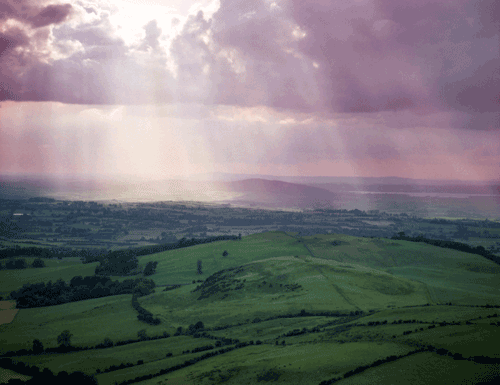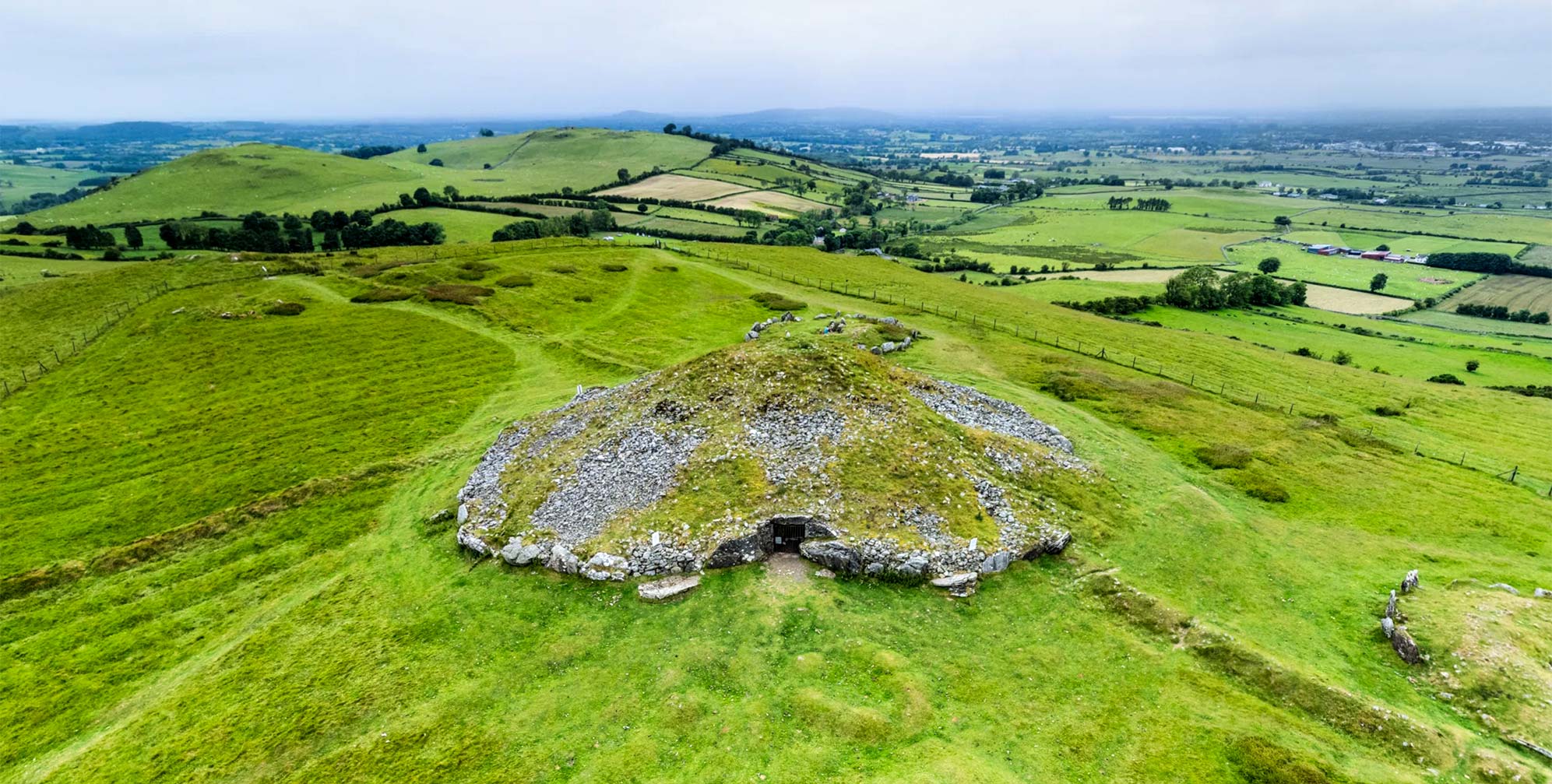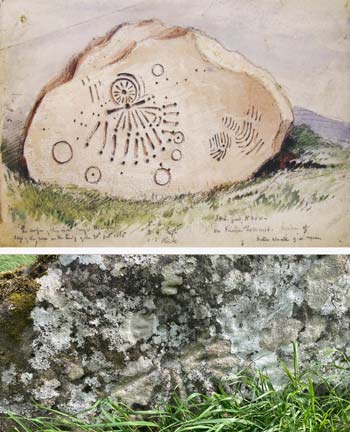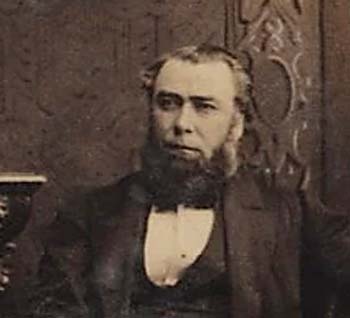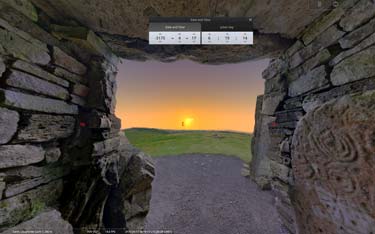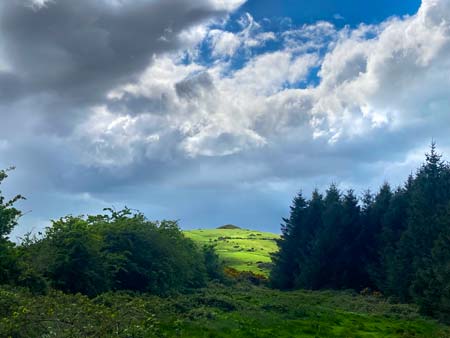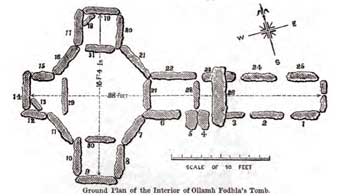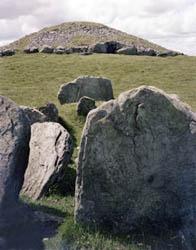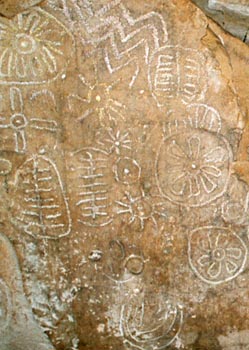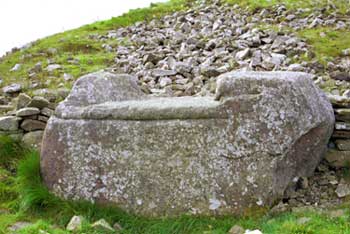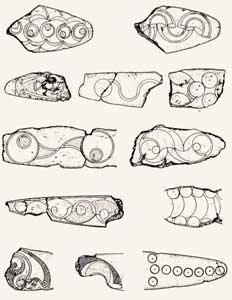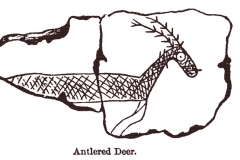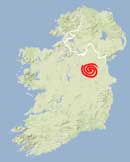05 Aug Loughcrew Passage Tombs
(Sliabh na Caillíghe)
“Determined now her tomb to build,
Her ample skirt with stones she filled,
And dropped a heap on Carnmore;
Then stepped one thousand yards, to Loar,
And dropped another goodly heap;
And then with one prodigious leap
Gained Carnbeg; and on its height
Displayed the wonders of her might.And when approached death’s awful doom,
Her chair was placed within the womb
Of hills whose tops with heather bloom.”
Jonathan Swift, c. 1720 1
On his visit to the Loughcrew hills, also called Sliabh na Caillíghe (The Hill of the Hag, or Witch) Jonathan Swift was determined to collect local folklore. With a friend acting as translator from the Irish, he heard tales of the “monster woman” who once ruled the area.2 The name of the ancient hag was Garavogue, the local incarnation of An Cailleach Bhéara, the Hag of Beare. As the legend goes, she was attempting a magical feat requiring her to drop an apronful of stones on three of the Loughcrew peaks, jumping from one to the next. Had she succeeded, she would have ruled over all of Ireland. She was able to drop her cairns of stones on the first two peaks, but missed her mark and fell to her death on her last leap. But as a result of her efforts the hills are crowned with a wonderful assortment of 5,000-year-old passage tombs in various states of preservation.3
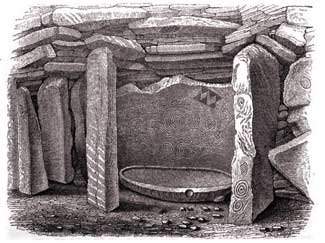
Stone basin in Cairn L Recess. (Eugene Conwell, 1873) See the interior of Cairn L in the virtual-reality tour (above).
Sliabh na Caillíghe constitutes a Neolithic necropolis, a passage-tomb cemetery with some evidence of at least thirty tombs, the grandest concentration of such monuments in Ireland. Over the centuries scores of others may have been destroyed with no trace remaining. Today many of the structures are present only in outline form, their covering cairns—tons of stone—deemed fair game for construction projects before the site was taken under the protection of the state.4 Some of the remaining tombs contain lavishly decorated orthostats, with engravings whose meanings have eluded archaeologists and inspired much earnest speculation. One ruined tomb, Cairn H, contained stunning evidence of its having acquired a new purpose sometime in the Iron Age: hundreds of elaborated incised bone fragments in the characteristic La Tène style (see illustration bottom right, and in the gallery). Some of the cairns have never been fully excavated and may yet contain hidden chambers.
The two hills in the townland of Loughcrew are named Carnbane (White Cairn) East and Carnbane West. The third hill of the Jonathan Swift poem lies in the townland of Patrickstown. Its cairns are entirely demolished, with just a few kerbstones to mark their locations, and a single decorated stone (below, left) remaining from the central cist of Cairn X1. Another nearby hill—Sliabh Rua, also known as Carraig Breac—holds Cairn M, with a diameter of about 20 m (66 ft).
If venturing out for an actual tour of the monuments the visitor will find Carnbane East freely accessible by a somewhat steep and winding footpath up the hill. Cairn T, on its summit was for many years a spectacular—often solitary—experience for the visitor, who would first fetch the key from a tea house below the hill. Unfortunately, the cairn is now (2025) closed due to concerns about its structural integrity. However, the cairn—with its lavish display of megalithic art—can be fully explored in our virtual-reality tour.5
The monuments on Carnbane West however are off limits, the landowner disallowing any public access.6 However in our virtual-reality tour both of the Loughcrew hills may be visited, and eight of the monuments explored in panoramic detail. The most extensive VR exploration is of Cairn T on Carnbane East,7 which allows entry into the deepest recess of the tomb.
Cairn L on the western hill may also be entered in virtual reality. Please note that the interactive map is not drawn to scale.8 Aside from our photographic virtual-reality tour, modern digital scanning and mapping technologies have enabled an interactive model of the exterior of Cairn T.
The two principal hills of Loughcrew have a total of 22 monuments remaining. Carnbane East, with Cairn T preserved and partially reconstructed in the 1960s, dominates its 275 m (904 ft) summit. Six ruined satellite chambered tombs surround it. Carnbane West holds 15 monuments, the largest being Cairn D (55 m or 180 ft in circumference) and Cairn L (45 m or 148 ft). The largest monument, Cairn D, was effectively vandalized in the 19th century during futile efforts to discover a chamber.
The Discovery of Loughcrew
It is astonishing, given its geographic prominence and the extent of its monuments, that John O’Donovan and the other meticulous investigators of the Ordnance Survey in the 1830s gave but scant attention to Sliabh na Caillíghe.9 Eugene A. Conwell undertook the first thorough exploration and mapping of the hilltops after he happened upon them during a picnic with his wife in 1863.
“When I first stated that I had discovered a series of hitherto unnoticed and undescribed cairns, extending for two miles along a range of hills, within forty miles of the city of Dublin, I was laughed at, naturally enough. I can only attribute their being left for me to investigate to the fact that, up to the time the omission was drawn attention to by me, the only indication of their existence on the Ordnance Survey Maps was a mere dot or two, with the word ‘Stones’ appended…” 10
Conwell proceeded in the next few years to thoroughly explore the tombs, conducting extensive excavations—unscientific by modern standards—with the assistance of the landowner. His use of the letters of the alphabet to designate the different cairns remains the nomenclature today. Some of Conwell’s observations are included below for the eight different monuments explored in our virtual-reality tour. Additional information has been gleaned from Jean McMann’s 1993 guide and from Martin Byrne’s website.
Today’s archaeologists are grateful that Conwell engaged an artist, G.V. Du Noyer, to make accurate paintings of the wealth of megalithic art in the tombs. These elaborate pictographs, once Conwell’s workers removed their cocoon of debris and exposed them to the elements, soon began to deteriorate. A sample of Du Noyer’s paintings may be noted, above left, and in the gallery.
Conwell, in the decade following his pioneering Loughcrew fieldwork, deviated from his careful observation and entered into the murky realm of fable-based speculation. In an endeavor to fit the monuments into the prevailing synthetic history of Ireland, he grandly suggested that Loughcrew was the site of the games of ancient Tailteann, even though the ceremonial mound in the townland of Teltown, 19 km (12 mi) away, was, and is today, generally considered the historical location of the games.11 Conwell also proposed that the throne-shaped stone at the side of Cairn T was where the great “law-giver king” of Irish legend, Ollamh Fodhla, first promulgated his legal code. Conwell further insisted that the ashes inside the cairn were the mortal remains of this monarch and lawgiver. The throne-shaped stone is labeled “Hag’s Chair” in our VR tour.
“And to whom…should this great megalithic chair be more appropriately ascribed than to Ollamh Fodhla? It would be natural to suppose that for the site of the tomb of the great King and law-maker, his posterity…selected the most elevated spot on the entire range. Hence, we propose to call the carn on that spot…Ollamh Fodhla’s Tomb; the great stone seat Ollamh Fodhla’s Chair; and the mined remains of the smaller surrounding carns…the tombs of his sons and grandsons…” 12
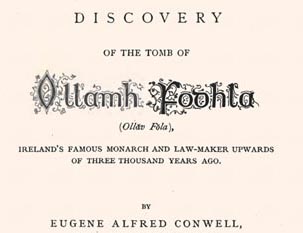
Conwell’s publications in the 1870s promoted his theory that Loughcrew was the site of the legendary Tailteann.
Alfred Conwell sought to decipher the story of Loughcrew by correlating the landscape with the legendary history depicted in medieval manuscripts. Another way of understanding the monuments may be found in the messages the builders left directly on the stones. Some maintain that the megalithic art is purely abstract, while others find the designs to be references to celestial objects, a female deity, or part of an effort to choreograph the experience of entering the tomb in a long-forgotten ritual event. The meanings of the designs on the massive orthostats—circles, dots, chevrons, zigzags, and triangles—may be tied to the ceremonial uses of the monuments. Most archaeologists now agree that while the cairns of Loughcrew were certainly tombs, they must also have served as ritual centers for community observances, perhaps tied to celestial events. While it is tempting to try to coax meaning from the visually compelling, deeply incised designs on the stones, it may be best to rather focus upon their innate beauty and appreciate how they connect us to a remote past (see illustrations below and in the gallery). As archaeologist Ronald Hutton put it, “…not only have we no legend for the map nor any cipher for the code before us, but we may be investing the symbols with a profundity which they did not possess.”13 More willing to take a leap of faith, archaeologist Carleton Jones suggests that
“Many of the design elements of megalithic art are most likely derived from hallucinations and that these hallucinations, however they were achieved, would have been interpreted within the prevailing Neolithic world-view…The important spiral motif found in megalithic art may have represented a vortex that allowed travel between different realms of existence…” 14
The extravagant megalithic art found on the backstone of the passage into Cairn T on Carnbane East may be viewed in our VR tour either by a beam of natural light or by artificial (strobe) light. Martin Brennan discovered in 1980 that this stone is positioned so that on the vernal and autumnal equinoxes the rising sun casts its light onto the intricate designs etched by the ancient builders.15 On those days, just before the dawn, visitors are eager to climb up the hill in the cold darkness and share the phenomenon. Photographs of the equinox sunrise may be seen here and here. A video of the phenomenon, courtesy of Boyne Valley Tours, may be seen near the bottom left of this page. Tours may also be booked with the nearby Loughcrew Megalithic Centre.
“…the rising and setting of some prominent celestial bodies was central to ritual traditions associated with death and the megalithic monuments in the prehistoric past, and embedded in the ideology and world view of people in the Neolithic.”
Dr. Frank Prendergast
Wouldn’t it be wonderful to have a time machine that could transport you back to an equinox sunrise during the Neolithic, say about the time Cairn T was built (c. 3200 BCE) where you could witness the first rays of light entering the tomb? In the hours before that sunrise, you would be able to look up into the night sky, free of modern-day light pollution and industrial haze, and see perhaps as many as 6000 stars, rather than just the few hundred visible today.
The next best thing to such a time machine is the free and open-source program Stellarium, a planetarium simulation which provides realistic visualizations of the positions of celestial bodies for any time in the past, present, or future. It is able to compute and simulate the night sky for any specified location on earth. Stellarium is available for most computer platforms and may be downloaded here.
In 2021 cultural archeoastronomer Dr. Frank Prendergast (Technological University Dublin, Emeritus) was commissioned by the National Monuments Service to create a Newgrange-specific landscape model that could be imported into Stellarium.
Inspired by Dr. Prendergast’s work, we repurposed one of our Loughcrew Cairn T VR nodes into a landscape model for Stellarium. This file may be downloaded here.
As far as Loughcrew and the solar equinox is concerned, Dr. Prendergast cautions, “In the Neolithic, there is no evidence in the archaeological record that agrarian societies had any concept of equinox or interest in the date of such an event….That is not say that the orientation of Cairn T has no significant solar alignment and significance. I prefer to state that the illumination of the decorated backstone is symbolically linked to the risen sun when it is about midway in its apparent journey between the extreme solstitial limits, leaving out the term ‘equinox’ and avoiding calendrical baggage. Interestingly, only a small number of passage tombs have such an orientation.” (F. Prendergast, personal communication, February 18, 2025)
The Hag of Beare
Even though Alfred Conwell’s bold assertions regarding the historical lineage of Cairn T welled up primarily from his own imagination, his explanation of the monument’s pedigree soon became a modern addendum to the folklore of the site.16 But Conwell’s contribution overlaid indigenous legends that may have already existed for a thousand years.
The folktales of the ancient Hag of Beare were the stories that greeted Conwell, John O’Donovan, and Jonathan Swift before him. This hoary figure may have had her origins in the Celtic goddess Buí, the Old Irish word for cow, and perhaps the origin of the other Irish sovereignty goddess, the River Boyne. The most striking feature of An Cailleach Bhéara was her unfathomably long life span. It was said of her “she passed into seven periods of youth, so that every husband used to pass to death from her, of old age, so that her grandchildren and great-grandchildren were peoples and races.”17
Legends of An Cailleach Bhéara are not unique to the Loughcrew Hills. She also figures prominently in the folklore of the passage tomb on the summit of Slieve Gullion, 64 k (40 mi) to the northeast in Co. Armagh. The Hag of Beare stories originated in the Beara Peninsula of Co. Cork, where, at Coulagh Bay, a natural rock is pointed out as her petrified remains. Also in Co. Cork the Labbacallee Wedge Tomb is said to be her burial site. As a sovereignty queen, she was given the personal names of Buí, or Digdi. In a very real sense, An Cailleach Bhéara acted as an Earth Mother, a supernatural figure who was a fundamental “creator and presider over the landscape.”19 In addition to dropping cairns on mountaintops, she also was responsible for placing large boulders in rivers, and sculpting rock formations on hillsides. Her geotectonic powers extended to creating islands in the seas, and transforming lakes into mountains. For An Cailleach Bhéara, her longevity evokes a sense of awe, but also a sadness stemming from the fragility of old age.
“I am poor Cailleach Bhéara,
Many a wonder have I ever seen;
I have seen Carn-Bane a lake,
Though it is now a mountain.” 20
The powers of An Cailleach Bhéara represent a striking alignment between our modern understanding of earth’s geological evolution and an ancient folk wisdom expressed metaphorically. The connection between geology and folklore also may be noted in modern popular culture.21
Folklorists and etymologists who have studied the traditions of An Cailleach Bhéara have considered a number of different cultural meanings for her, including the Divine Hag, the dark side of the Mother Goddess, as well as the Sovereignty Queen. A complex figure, she is represented widely in the country, giving her name often to local spirits or deities, along with a more localized epithet. She is also known as the “supernatural female wilderness figure” always at odds with the human world. These ancient tales of opposing forces may represent an “extremely ancient formulation” of such a pattern into the historical era of Gaelic oral tradition.22 One aspect of this opposition may be represented by the frequently heard story that explains why a human child, unlike the young of most animals, is unable to walk as soon as it’s born. The story relates how An Cailleach Bhéara put her hand on the small of the back of a newborn, and ever after that child—and all children—were unable to walk when entering the world.23
By the time the ancient oral traditions of the Hag were committed to writing, perhaps beginning in the early ninth century, cailleach, from “old veiled one,” came primarily to signify a woman religious—a nun. The medieval scribes who wrote down these local stories, in order to conform the tales to a patriarchal and Christian perspective, transformed this goddess of destruction and renewal into a pitiable old woman who finds her consolation in Christ.24 Some have suggested a connection between the dimly recalled powers of An Cailleach Bhéara and the graphic depictions of female generative energy seen in the sheela-na-gig carvings found on the walls of some old churches, such as at the Ballyvourney Monastic Site in Co. Cork.25
One story of An Cailleach Bhéara that demonstrates her residual powers, and how they were delimited by the new belief system, was expressed in a story collected by the Irish Folklore Commission. In this object-lesson tale, the Hag scolded her servant boy for going out to turn the hay when she had used her ability to commune with nature to predict that it would be too wet for such work. The boy then responded, in a patriarchal and dismissive tone:
“Believe not the scald-crow nor the deer
And place no store by the word of a woman;
Whether the sun rises early or late
The day that ensues will be as God disposes.” 26
Perhaps the saddest, and most evocative, of all the texts associated with the Hag of Beare are the verses of “The Lament of the Old Woman of Beare,” dating in different forms from as early as the ninth century. It has been called “one of the most remarkable poems which medieval Ireland produced.27 In this poem, An Cailleach Bhéara is a fabled creature of the distant past, once able to renew her power from the endless forces of nature, but now faced with the pitiful degradation afforded old women in a new patriarchal society. Even though, in some translations, she is depicted as having gladly taken a nun’s veil, she still mourns for the life, and youth, she has left behind.
“Now my hands, wrinkled to long
bones, hang down dead, hands that locked
kings of this land in loving,
in the old days, my lost days.
O hands, wrinkled to long bones
even at my odd hours of lust
I must tell young men begone
should they come. I have no love.
…
Not the old I envy:
they die; but youth
and monuments, both assailed
as I am, and they still hold.
Winter makes war with the waves;
today no king will come here,
nor the lowest road-walker.
I expect no one today.”
From “The Hag of Beare,” by Michael Hartnett (1969)28
Hartnett’s translation may be read in its entirety in the footnote.
A 1994 translation by Anthony Weir, illustrated with his photographs, may be viewed here. Other translations include those by Kuno Meyer (1899), Lady Gregory (1919), and Gerard Murphy (1952). Pádraic Pearse’s patriotic evocation of the Hag figure, “Mise Éire,” will be familiar to most Irish schoolchildren.
The Monuments
The Loughcrew Passage Tomb Complex is one of the main megalithic cemeteries found on a line stretching west to east across the middle of the country from Knocknarea and Carrowmore near the Sligo coast to the fabled Brú na Bóinne tombs a bit farther to the east in Co. Meath. The eight Loughcrew monuments explored in our virtual-reality tour are described below. There are four sites to explore on Carnbane East and four on Carnbane West. Three of the passage tombs may be entered on the VR tour: the partially restored Cairns T and L, and the ruined Cairn H.
Carnbane East
Cairn T is the principal monument of the entire Loughcrew complex, sitting on its summit, the highest point in Co. Meath. Known as “The Hag’s Cairn,” it features a treasure-trove of megalithic art on its decorated orthostats, and 360° views over 18 counties from the top of the passage tomb. In our VR tour, the view from the top of the cairn is where a hotspot connecting to Carnbane West is found. The mound is 35 m (115 ft) in diameter, with an 8.8 m (29 ft) passageway from its entrance to the backstone of its inner chamber. The passage may be explored in detail, with hotspots at four different positions. The final hotspot is at the cruciform 3 m- (10 ft-) high inner chamber with its corbelled roof and three side recesses, each with its own corbelling.
When Conwell first excavated the tomb in 1864 he discovered evidence of human cremation: charred bones and charcoal. Cairn T serves as a focal point for the six smaller tombs clustered around it. The name for these hills, “Carnbane,” which means “white cairn,” may have stemmed from the observation, in old records, that Cairn T once had a cladding of gleaming white quartz, similar to that seen today at Newgrange, above its supporting circle of 42 kerbstones. Some have observed that progressing deeper into the tomb’s passage reveals increasingly complex megalithic art, with the most ornate decoration found on the underside of the capstone of the western recess, visible only by leaning into the space and peering upwards.29 The backstone, richly decorated and illuminated by the equinox sunrise in a 50-minute display, may be explored in two versions in the VR tour. When Conwell first entered the tomb he found it in a collapsed state:
“The entrance to the passage was closed by two irregular blocks of stone, inside of which were dropped three other large blocks of stone, filling up the passage for five or six feet in length. On the outside of the entrance was placed a loose layer of lumps of quartz. All the roofing flags covering the passage, and more than two-thirds of what originally covered in the central octagonal chamber, had disappeared, leaving the passage and central chambers completely filled up with stones.” 30
The Hag’s Chair
A kerbstone just within the northern periphery of Cairn T, the Hag’s Chair is a massive block with imposing armrests carved from the stone. It is 3 m (10 ft) long and 1.8 m (6 ft) high, with an estimated weight of 10 tons. Its carvings, now much degraded, may be seen in the illustration in the gallery. A deeply-incised cross carved into its seat was noted by Conwell as a nineteenth-century trigonometric mark, although others have claimed it to be an artifact of the monument’s use as a “Mass rock” during Penal times.31 Conwell is also responsible for creating the enduring legend that considers this rock to be the throne of the mythical lawgiver-king Ollamh Fodhla.32 The earlier tales, of An Cailleach Bhéara, suggested that she sat on this chair and looked out over her domain. Local lore states that a modern visitor, seated on the chair, will be granted a single wish.
Cairn S
When Conwell excavated the ruined Cairns S in the 1860s he discovered “a perfect specimen of a leaf-shaped arrowhead,” as well as a passage “filled up to the height of eighteen inches with charred bones.” The chamber features six ornamented stones and a round kerb of 35 boulders, 17 m (56 ft) in diameter.
Cairn U
This is a ruined passage tomb 13 m (42.6 ft) in diameter, the top of its covering cairn removed, the tomb is now defined by its 16 kerbstones. Situated near the end of the winding path up to the top of Carnbane East, this monument is the first one encountered by visitors. It cruciform chamber is at the end of a 7 m (23 ft) passage. There are 13 stones with megalithic art in the tomb. When discovered by Conwell, the chambers were largely filled with collapsed stones and earthen debris. “When the stones which filled up these chambers were removed, the earth at the bottom, in some places from twelve to eighteen inches in depth, was found to be thickly mixed with splinters of burned bones.”33
Cairn V
Here are some remaining kerbstones and uprights, four of them with inscriptions. The tomb is some 10 m (33 ft) in diameter. It chamber follows a double-cruciform design, with an end recess connected to two smaller recesses on each side. A large stone, noted in the VR panorama, stands apart from the structure of the tomb, a couple of meters in the direction of Cairn T. Conwell wrote: “Digging round the base of this stone, in a fruitless search for engravings, I turned up a long, rounded, white sea pebble, which, from appearances, may have been used as a sling stone or a hammer.”34 Conwell also reported finding, after digging through the debris to the bottom of the tomb, “a splendid stone urn…[with] some splinters of charred bones…found beneath it.”
Carnbane West
Please note that the monuments of Carnbane West are on private property and unfortunately not now (2025) accessible to the public. Furthermore, the entry to Cairn L is closed by a locked iron gate. Our virtual-reality tour includes the monuments on this hill by special arrangements with the concerned parties.
Cairn H
When excavated by Conwell Cairn H was found to contain hundreds of bone fragments, later dated to the Iron Age, some 500 of which were incised with compass-drawn La Tène style designs. See illustration, right, and in the gallery. It may be that these decorated bone flakes were placed into the passage tomb, some 3,000 years after its construction, as a votive offering to its long forgotten, but still respected, spiritual powers. The appearance of bronze rings, bone pins, and glass beads also found in this location would seem to support that hypothesis. Another possibility is that the cairn was the location of an oracle, who may have “read” the decorated bone fragments, as would a fortune-teller. It also may be that the tomb was the location of a design workshop, and the inscribed stones were simply practice sketch-pieces for the finished articles of ornamentation. Conwell also reporting noting “some curious attempts at dry masonry” in the end chambers, which likely indicated a more recent construction in that area.35
“Underneath the stone basin in the northern chamber were found imbedded in damp earth, and mixed with small splinters of burnt bones, six stone balls, the largest about an inch in diameter, but in so soft a state, that they could scarcely be touched without injuring them…Chiefly in the southern chamber, and about the entrance to it, for the most part imbedded in wet stiff earth, I got the most remarkable collection of bone implements, glass, amber, bronze, and iron, which probably has ever been found together under similar circumstances… On one, in cross-hatch lines, is the representation of an antlered stag, being the only attempt in the collection to depict any living thing.” [See illustration in gallery] 36
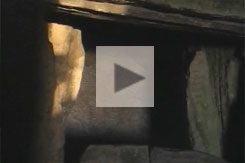
The progress of the sunbeam on the backstone of Cairn T was recorded at sunrise on March 23rd, 2005. The 50 minute video has been compressed here to 1 minute.
The tomb can be viewed from two positions in the virtual-reality tour, from atop the remains of its cairn, and from inside its open-air passage. It has a typical cruciform chamber inside its mound of some 16 m (52.5 ft) in diameter. Its passage is 4 m (13 ft) in length. The sill-stone that separates the chamber from its right-hand recess contains spiral designs. Although Conwell was the only one to excavate many of the Loughcrew monuments, Cairn H was also excavated in 1943 by archaeologist Joseph Raftery, who discovered a further 3,000 bone fragments, with 300 bearing some design work. Dr. Raftery seemed to conclude that the monument was actually constructed in the Iron Age. Conwell’s trove of incised bone blades, left in 1870 with the Anthropological Society in London for their examination, was never seen again.37
Cairn L
Although its entrance passage has been diminished and reconstructed, the intact chamber of Cairn L is well preserved. The remnants of its corbelled roof, once perhaps 5 m (16 ft) or higher, are now protected by a concrete dome built in the 1960s. The seven recesses, or stalls, of the tomb consist of three at each side and one at the end, each formed from upright slabs. There are 18 decorated stones in this large tomb, 41 m (135 ft) in diameter, with 41 huge kerbstones defining its perimeter. Unique among the intact Irish passage tombs, Cairn L features a non-structural standing stone within its chamber, positioned near a 155 cm- (5.8 ft-) long stone basin, also seen in the gallery below. This stone, standing guard at the entrance to the most prominent chamber, is made of blue limestone, contrasting sharply with all the other structural stones in the cairn, which are of brown sandstone.38 The chamber has a solar alignment that admits the sunrise light twice each year, illuminating the basin and the richly engraved panel beyond it. Conwell described this chamber thusly:
“Completely filling up the length of the opposite chamber, entered through a space only two feet wide between two upright stone pillars, rests an oval-shaped stone dish or basin, probably the largest yet discovered in a cairn…The exquisite tooled or picked workmanship of this stone will amply repay a careful examination. On raising this stone, several splinters of blackened charred bones were observable; and…48 human teeth in a very perfect state of preservation; the pointed end of a bone pin, 51 inches long, and a quarter of an inch thick; a piece, about an inch in length, of a similar bone pin; a most perfectly rounded syenite [granite-like] ball, still preserving its original polish—a most beautiful object…” 39
Cairns F and G
with a circumference of 47 m (154 ft), Cairn F is paired with its neighbor Cairn G, their kerbs practically interlocking. Its cruciform chamber is oriented east and contained several decorated stones, most easily noted in oblique light. When excavated by Conwell in 1865 the site yielded a stone basin and a “brown ironstone ball, three inches in diameter, and well rounded.”
Cairn D
The view in our VR tour that shows Cairn D from the camera position at Cairn F looks into the yawning scar of the crater left by Conwell’s repeated efforts to discover a passage into the cairn. Although he removed many tons of stone, never replaced, he was unsuccessful in locating the chamber (if one exists). Conwell did, however, find some animal bones during his work, which today would be labeled antiquarian vandalism.40 The monument, with a diameter of some 55 m (180 ft) is the largest of the Loughcrew cairns. Prior to Conwell’s depredations, it had a “perfect” kerb of 54 large flagstones. Along with Knocknarea’s Misgaun Maeve, and the Heapstown Cairn near Lough Arrow (both in Co. Sligo), it remains one of the largest unopened cairns in the country, perhaps holding its secrets for a generation of archaeologists yet unborn. As Jean McMann observed,
“All interpretations, even those of archaeologists, are to some degree subjective. We might say that they are informed guesses. Because our thoughts and perceptions are restricted by the language and customs of our times, it is nearly impossible for us to imagine what might lie outside those limits. And yet, because we possess the physical and mental attributes of ancient people, we may experience similar sensations in this place, as we see the same hills, stones, and sky. Without believing that we can ‘correctly’ picture a past that is forever out of our reach, we can nonetheless feel connected to that past through imagination, informed by our own perceptions and the evidence left to us.” 41
Click here to see all the notes from this page.
Loughcrew Passage Tombs, Co. Meath
Nearest Town: Oldcastle
Townland: Carnbane
Latitude: 53° 44′ 32.88″ N
Longitude: 7° 8′ 10.09″ W



